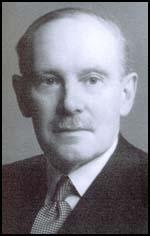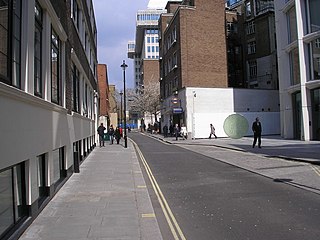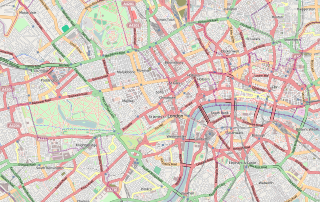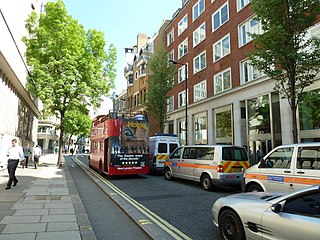
Harold Adrian Russell "Kim" Philby was a high-ranking member of British intelligence who worked as a double agent before defecting to the Soviet Union in 1963. He served as both an NKVD and KGB operative.

Major General Sir Stewart Graham Menzies, was Chief of MI6, the British Secret Intelligence Service (SIS), from 1939 to 1952, during and after the Second World War.

A mansion is a large dwelling house. The word itself derives through Old French from the Latin word mansio "dwelling", an abstract noun derived from the verb manere "to dwell". The English word manse originally defined a property large enough for the parish priest to maintain himself, but a mansion is no longer self-sustaining in this way. Manor comes from the same root—territorial holdings granted to a lord who would "remain" there...

Grosvenor House was one of the largest private townhouses situated on Park Lane in London, England. The house was the London home of the Grosvenor family for more than a century. Their original London residence was on Millbank, but after the family had developed their Mayfair estates, they moved to Park Lane to build a house worthy of their wealth, status and influence in the 19th century.

Northumberland House was a large Jacobean townhouse in London, which was so called because for most of its history it was the London residence of the Percy family, who were the Earls and later Dukes of Northumberland, and one of England's richest and most prominent aristocratic dynasties for many centuries. It stood at the far western end of the Strand from around 1605 until demolished in 1874. In its later years it overlooked Trafalgar Square.

Clarendon House was a town mansion which stood on Piccadilly in London, England, from the 1660s to the 1680s. It was built for the powerful politician Edward Hyde, 1st Earl of Clarendon, and was the grandest private London residence of its era.

Cambridge House is a grade I listed townhouse in central London. It sits on the northern side of Piccadilly in the fashionable district of Mayfair. The current name of the house comes from one of its owners, Prince Adolphus, Duke of Cambridge (1774–1850), the 7th son of King George III, but it was originally known as Egremont House, and later as Cholmondeley House. From about 1865 to 1999 it was the home of the Naval and Military Club, and is known colloquially as the In and Out Club due to its prominently signposted one-way carriage drive. It has been empty since 1999.

Broadway is a street in the City of Westminster in London that runs between Petty France, Queen Anne's Gate, Carteret Street and Tothill Street in the north and Victoria Street in the south. It is joined on the west side by St Ermin's Hill and Caxton Street, and on the east side by Dacre Street.

The Renaissance City Apartments is an upscale residential skyscraper located at 555 Brush Street in Downtown Detroit, Michigan. It is one of Detroit's tallest residential buildings, standing at 33 floors. It was constructed in 1985 in the Modern architectural style adjacent to the similarly designed Courtyard by Marriott – Downtown Detroit.

There are 14 Grey Streets in metropolitan Melbourne, but by far the best-known is Grey Street in St Kilda, once a grand residential street but now with a reputation as a centre of prostitution.

Millender Center station is a Detroit People Mover station in Downtown Detroit, Michigan. It is located inside the Millender Center complex at Level 5. It serves the Courtyard by Marriott hotel and residential apartments. The building is also connected by two separate skywalks to the Renaissance Center and the Coleman A. Young Municipal Center.
Edwin Thomas Hall (1851–1923) was a British architect known primarily for the design of the Liberty & Co. department store, the Old Library at Dulwich College (1902–03) and various hospitals. He was the brother of the architect George Alfred Hall and father of Edwin Stanley Hall, also a noted architect.

The Humble Oil Building, is a historic office building, designed in the Italian Renaissance architecture style, located at 1212 Main Street in Houston, Texas and listed on the National Register of Historic Places. It was constructed by Humble Oil and Refining Company in 1921. The tower section was added on to the building in 1936. The building complex served as the company headquarters for Humble Oil and Refining Company from 1921 until 1963, when the company moved into what is now the ExxonMobil Building at 800 Bell Street. In 2003, the building complex was renovated for use as a combination hotel and apartments, the apartment section was converted to additional hotel rooms in 2015.
The Secret Intelligence Service (SIS), commonly known as MI6, is the foreign intelligence service of the government of the United Kingdom, tasked mainly with the covert overseas collection and analysis of human intelligence (HUMINT) in support of the UK's national security. SIS is a member of the country's intelligence community and its Chief is accountable to the country's Foreign Secretary.

General Patrick Hurley opened the Ambassador Hotel in 1929, intending it to be a luxury "extended stay" residence for Tulsa businessmen, who were building mansions that were not yet ready for occupancy. Hurley never stayed in the hotel he founded. He moved to Washington, D. C. in March 1929, after President Herbert Hoover chose him to be Secretary of War, after the death of the previous Secretary, who died in December 1929. Hurley never returned to Tulsa.

Clarence Gate Gardens, also known as Clarence Gate Mansions, are Edwardian, Arts and Crafts and Art-Nouveau-inspired mansion blocks next to Regent's Park in Marylebone, London.

Nob Hill is a neighborhood of San Francisco, California that is known for the numerous luxury hotels and historic mansions, Nob Hill has historically served as a center of San Francisco's upper class. Nob Hill is among the highest-income neighborhoods in the United States, as well as one of the most desirable and expensive real estate markets in the country.
The Ashridge Dining Club was a political club set up in 1933 in West London with the object of extending the associations and activities of the Bonar Law College, Ashridge, by discussion over the dinner table. The Bonar Law College had been opened in 1929 by Stanley Baldwin having been presented to the Conservative Party by Mr Urban Broughton as a training college for Conservative workers. It was named as a memorial to Bonar Law, the British Conservative Party politician and Prime Minister, who had died in 1923. The aim of the College was to provide political education and was not explicitly Conservative.

Palmer Street is a street in the City of Westminster in London that runs between Petty France in the north and Victoria Street in the south. It is crossed by Caxton Street and Butler Place. The lower half of Palmer Street, below Caxton Street, is pedestrianised.

Caxton Street is a street in the City of Westminster in London that runs between Buckingham Gate in the west and Broadway in the east. It is joined on the north side by Vandon Street and crossed by Palmer Street.



























